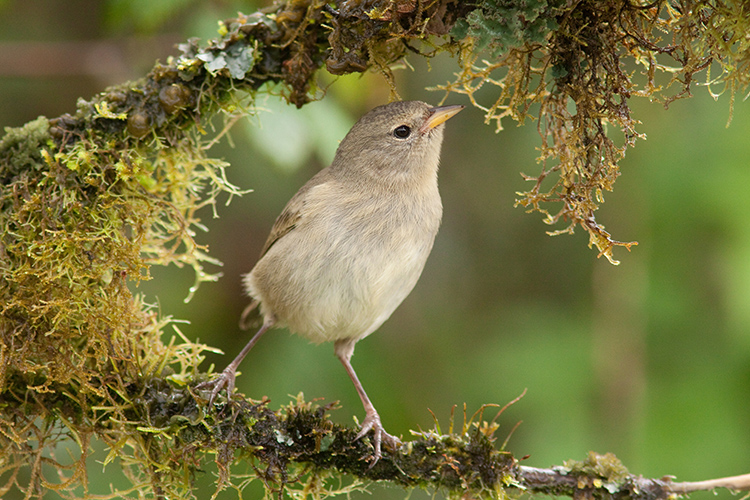Galapagos Species Database
The Galapagos Species Database shares the information about the species from our Natural History Collections.
Certhidea fusca
Pinzón Reinita Gris, Pinzón cantor gris, Gray Warbler Finch

The smallest of all Darwin finches, about 8 grams, and the species with the thinnest beak.
Threats As for other finches, threats are probably now mainly introduced diseases.
Domain
Eukaryota
Kingdom
Animalia
Phylum
Chordata
Class
Aves
Order
Passeriformes
Family
Thraupidae
Genus
Certhidea
Species
fusca
Taxon category: Accepted
This species is closely related to the Green Warbler Finch, and were formerly considered conspecific, but both species differed in appearance, distribution, habitat, and song. Syn.: Certhidea olivacea Gould, 1837. A recent genetic study has shown a single colonization event about 850 000 yrs ago from southern central America rather than continental Ecuador.
Taxon origin: Endemic
Preference for an altitude zone in Galapagos: Dry zone - transition zone
Habitat preferences: Found in drier habitats than C. olivacea, but also at moderate to high elevation on San Cristóbal.
Substrate or host preferences: Forages in trees and shrubs, searching foliage leaf clusters and epiphytes and probing mosses (especially during the dry season), for arthropods.
Trophic role: Carnivorous
Reproductive biology: Male displays in front of a dome shape nest. Once chosen, the pair either use this nest or build a new one. Only females incubate (two to three eggs), both feed the chicks. Fledglings stay for up to 6 weeks with a parent, either with the male while the female starts a new clutch, or, one with the female and the other with the male.
Distribution: C. fusca is found on the smaller islands in the north, east and south of the archipelago, practically spanning the entire length of the archipelago. Present on Darwin, Wolf, Española, Santa Fe, San Cristobal, Pinta, Floreana.
- Wiedenfeld, D.A. (2006) Aves, the Galapagos Islands, Ecuador. Check List 2006 2(2): 1-27.
- Harris, M.P. (1973) The Galápagos avifauna. Condor 75(3): 265-278.
- Salvin, O. (1876) On the avifauna of the Galápagos Archipelago. Transactions of the Zoological Society of London 9: 447-510.
- Castro, I. Phillips, A. (1996) A Guide to the Birds of the Galapagos Islands. Christopher Helm Publishers Ltd., London.
- Swarth, H.S. (1931) The Avifauna of the Galapagos Islands. Occ. Pap. Calif. Acad. Sci. 18: 1-299.
- Guerrero, A. Tye, A. (2009) Darwin's Finches as seed predators and dispersers. The Wilson Journal Of Ornithology 121 (4):752-764, 2009
- Remsen, J.V Cadena, C. D., Jaramillo, A., Nores, M., Pacheco, J. F., Pérez-Emán, J., Robbins, M. B., Stiles, F. G., Stotz, D. F., and Zimmer, K. J. (2012) A classification of the bird species of South America. American Ornithologists' Union http://www.museum.lsu.edu/~Remsen/SACCBaseline.html
- Farrington, H. Petren, K. (2011) A century of genetic change and metapopulation dynamics in the Galápagos warbler finches (Certhidea). Evolution 65:3148-3161.
- Grant, B.R. Grant, P.R. (2002) Lack of premating isolation at the base of a phylogenic tree. The American Naturalist 160:1-19.
- Grant, P.R. Grant, B., Petren, K. & Keller, L (2005) Extinction behind our backs: the possible fate of one of the Darwin's finch species on Isla Floreana, Galápagos. Biological Conservation 122:499-503.
- Petren, K. Grant, B. & Grant, P. (1999) A phylogeny of Darwin's finches based on microsatellite DNA length variation. Proceedings of the Royal Society of London Series B-Biological Sciences 266:321-329.
- Petren, K. Grant, P., Grant, B. & Keller, L. (2005) Comparative landscape genetics and the adaptive radiation of Darwin’s finches: the role of peripheral isolation. Molecular Ecology 14:2943-2957.
- Tonnis, B. Grant, P., Grant, B. & Petren, K. (2005) Habitat selection and ecological speciation in Galápagos warbler finches (Certhidea olivacea and Certhidea fusca). Proceedings of the Royal Society of London Series B-Biological Sciences 272:819-826.
- Farrington, H. Lawson, L., Clark, C. & Petren, K. (2014) The evolutionary history of Darwin's finches: speciation, gene flow, and introgression in a fragmented landscape. Evolution doi 10.1111/evo.12484.
- IUCN (2015) The IUCN Red List of Threatened Species. Version 2015-4. <www.iucnredlist.org>. Downloaded on 20 November 2015.
- Lamichhaney, S. Berglund, J., Sällman Almén, M., Maqbool, K., Grabherr, M., Martinez-Barrio, A., Promerova, M., Rubin, C.J., Wang, C., Zamani, N., Grant, B.R., Grant, P.R., Webster, M.T., Andersson, L. (2015) Evolution of Darwin’s finches and their beaks revealed by genome sequencing Nature 518: 371-386. doi:10.1038/nature14181
- Remsen, J.V. Areta, J.I.Jr., Cadena, C.D., Claramunt, S., Jaramillo, A., Pacheco, J.F., Pérez-Emán, J., Robbins, M.B., Stiles, F.G., Stotz, D.F., Zimmer, K. J. (2016) A Classification of the Bird Species of South America. South American Classification Committee. American Ornithologists' Union http://www.museum.lsu.edu/~Remsen/SACCBaseline.htm
- IUCN (2017) The IUCN Red List of Threatened Species Version 2016-3. <www.iucnredlist.org>. Downloaded on 03 February 2017.
- Freile, J.F. Santander, T., Jiménez-Uzcátegui, G., Carrasco, L., Cisneros-Heredia, D., Guevara, E., Sánchez-Nivicela, M., Tinoco, B. (2019) Lista Roja de las aves del Ecuador Quito, Ecuador. 97 pp.



Feeding type: Insectivorous